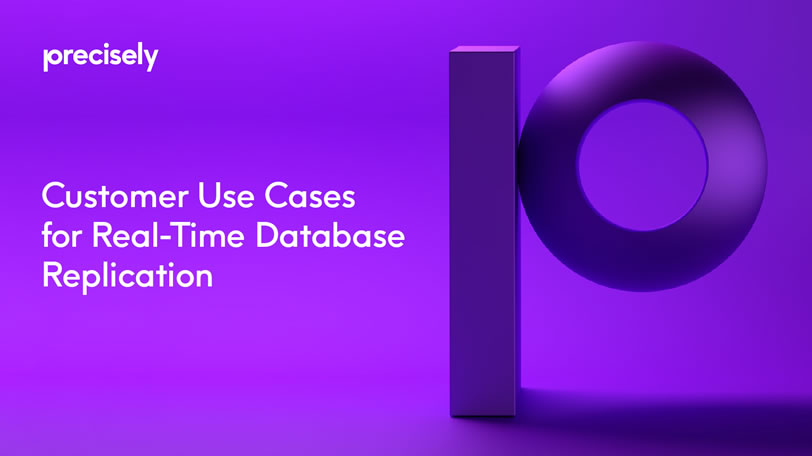eBook
Customer Use Cases for Real-Time Database Replication
In today’s IT environment, critical business information often resides across a variety of databases within the enterprise. The reasons leading to this configuration are many, but the result is often silos of information that cannot be shared with other silos. Frequently, portions of the data contained in each system are redundant, but not necessarily in sync across platforms.
This puts the business at risk of making decisions based on out-of-date, divergent, inaccurate data. Isolated information silos simply do not work well in the real-time, on-demand business world.
The following are examples of how companies are using the data replication capabilities of the Precisely data integration solution, Connect, for easy, automated real-time data sharing to drive their businesses forward.

Amway India: Driving e-commerce adoption and profitability with real-time reporting
For Amway India, a wholly-owned subsidiary of Amway Corporation, e-commerce represents an important component of its growth strategy. Sales increased to 31% of the company’s business over the course of two years, but continued growth relied on adoption and increased usage by its 550,000 active independent Amway Business Owners (ABO). The more up-to-date and accurate the data in the e-commerce platform is, the more likely it will be used by the ABOs.
The company’s e-commerce application relies on data from its ERP system, but data sharing between these platforms presented a problem for Amway. To prevent performance degradation during busy daytime business hours, most bulk data transfers were done at night. As a result, the e-commerce databases were out of date, forcing the ABOs to work with data that could be 24-48 hours old.
Amway India needed a way to provide the most up-to-date information to their independent business owners without impacting the performance of their production systems.
Requirements:
- Real-time, fully automated cross-platform data replication
- No impact on source and target database resources
- Ability to monitor the health of the replication processes across all platforms
Key Results:
- Data is made available immediately after it is entered or updated, enabling ABOs to begin ordering right away
- Increased adoption of e-commerce by ABOs, which increased profitability because electronic order processing is more cost- effective than other order-processing channels
- Fully automated data sharing, reducing manual workloads
- Reduced resource usage extended the life of its computing infrastructure by one year—about 25% of its previous replacement cycle

Wheeler Machinery Company: Making customer-focused decisions with the right data, at the right time
Wheeler’s business is all about providing high levels of service to their heavy equipment customers. Its managers need timely access to information in order to make critical decisions quickly. The business intelligence (BI) software used to provide this information accesses vast quantities of data from the ERP system and then “slices and dices” it in ways that allow Wheeler’s managers to spot important issues that demand attention.
However, Wheeler had several challenges in delivering this critical information.
They relied on nightly or weekly snapshots of production data to avoid impacting performance of other business applications on the production systems. This meant managers were working with data that was not current.
In addition, ongoing replication interruptions between its systems caused the company to begin to lose confidence with the data and processes it used for servicing its customers. There were numerous occasions when replication would fail just, and as a result, key metrics and critical score cards the company relied on would not get distributed.
Lastly, when they had to recover from a replication outage, the restart point could be slightly off, causing issues such as gaps in the data which would only come to light when their users complained. As a result, they started questioning the overall validity of the data.
Wheeler needed a reliable, real-time database replication solution that instilled confidence with business users by delivering timely, accurate data that can be relied on and trusted.
Key Results:
- Managers can make time-sensitive decisions using real-time data
- 100% more reliable data, with the ability to bring systems back online in the event of a hardware failure, replicating from the correct position without any human intervention
- No nightly data extracts to stock the data warehouses
- Specialized data base indexes optimize BI performance, without impacting production systems
- Replication processes are automated and do not require any day-to-day management
Database to database replication requirements:
- If there is a connectivity failure, network failure, or source, target, and application server failure, automatically recover data without the need for manual intervention or resynchronization
- The ability to keep track of exactly where the data transfer left off and automatically restart at that exact point – with no manual intervention, with zero data loss and zero data deduplication
- A solution that would NOT change the technology architecture– with business process in place and tested, if real-time data was correct, the existing architecture was exactly as the company wanted
- Share data between incompatible databases that is transparent to users but does not require operator intervention
- Remove nightly ETL jobs and base decisions on accurate real-time information
- Optimize BI database performance in which maintaining them does not affect the performance of other operational applications
Barona Resort & Casino: Providing a connected customer experience with real-time data
Barona Resort & Casino includes a 400-room hotel, 11 restaurants, golf course, spa and thousands of slot and video poker machines, as well as gaming tables. The company wanted to provide a connected customer experience between its player’s club “Club Barona” ID card and a new web-based portal called “Player’s Lounge,” where guests could log-in to see new offers and current player point levels.
The Player’s Lounge was a critical component of the Barona Resort & Casino engaging more with their guests who had signed up for the Club Barona ID card. Using the Barona ID card, members play the slot machines and gaming tables, and points are automatically added to their accounts. These points can be redeemed for free plays and complementary benefits across the resort. Since many of the Barona Club members lived less than 20 minutes from the casino, there was the need to update the Player’s lounge quickly enough that members could see points as soon as they logged in at home.
However, there is a gaming mandate that no outside systems should be able to access production data. To perform these connections, data would be required to enter an area beyond the firewall that protects production systems. Barona Resort & Casino needed to find a solution that would facilitate data replication securely, seamlessly, rapidly, and automatically.
Key Results:
- Customers can view their account data and update their personal information, such as their addresses, but the Web-based applications and users cannot access or change production systems or data
- There are no requirements for ongoing administration
- Most of the replication processing runs on separate system, thereby minimizing the load on the production server
Database to database replication requirements:
- The ability to replicate data between a mix of hardware, operating systems and database platforms in real time. Data that feeds from the Player’s Lounge comes from a combination of IBM i databases running on an IBM Power System server and Microsoft SQL Server databases running on Windows servers
- Data replication that would only touch necessary data through the firewall from production systems to the Player’s Lounge sever which sits between two firewalls – including a firewall to protect production systems from the outside world
- Minimize the load on its production servers when members need to update information
- Easy to use user interface that would allow employees to set up, test and revert back to replication models with little need for specialized skills


Getinge North America: Empowering business users to do more with their data
Getinge North America, a leading supplier of equipment and services for cleaning, disinfection and sterilization of medical instruments, wanted to leverage as much data as possible to give its employees analytical and reporting tools for important business insights. These business insights would help employees gain insight into business processes and customer behaviors, as well as identify any issues.
The company wanted to get these insights without holding up employees work or cause a customer to have to wait for a response from an application.
Getinge was accessing a lot of data very quickly and put a heavy strain on disk I/O channels, slowing down access for other applications – especially transactional applications for CPU resources. In addition, Getinge’s platform of choice for operational applications, Power Systems, IBM i and Db2 for i, was not the platform of choice for queries, reporting and analytics. Getinge prefers to use Windows-based servers running Microsoft SQL Server for that purpose. Getinge needed a way to allow users to query, report on and analyze real-time data, without negatively impacting transaction response times.
Key Results:
- Users can work with fully up-to-date data despite not working on the production system
- Facilitates extensive querying, reporting and analytics without impacting transaction processing
- Virtually no ongoing monitoring or management of change data capture activities
Database to database replication requirements:
- Platform-agnostic solution to replicate data in real-time from its ERP Db2 database running on an IBM i-based Power System server to a Microsoft SQL Server database running on a Microsoft Windows Server system
- Conserve storage and bandwidth by only copying data that is needed for queries, analysis, or reports
- No impact on production operations